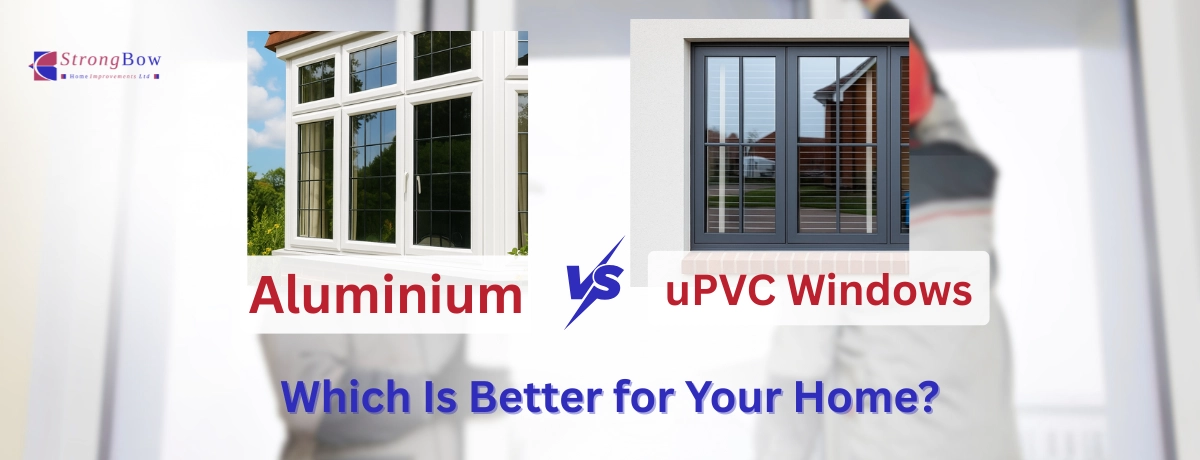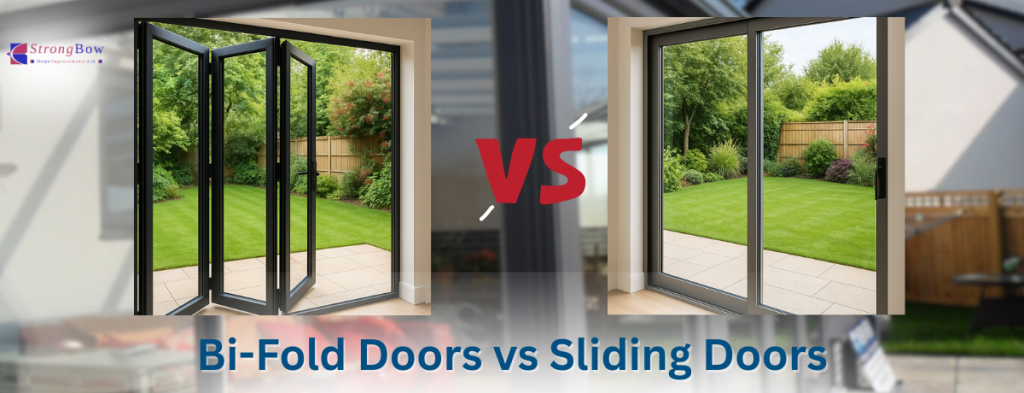After more than 30 years of improving homes and offices across the UK, we’ve heard the same question time and again: “Should I go for aluminium or uPVC windows?”
Both have their loyal fans, and for a good reason.
Aluminium brings a sharp, modern look that lasts for decades, while uPVC delivers warmth and insulation at a price most homeowners love. But beyond looks and cost, the two materials behave very differently once fitted.
Drawing on our own installation experience here in West Yorkshire and nearby areas, we’ve compared how both aluminium and uPVC windows perform in real homes. You’ll find differences in energy savings, everyday maintenance, and more, and thus, easily decide which one’s the better fit for your property and budget.
Let’s have a look.
Also check out: How Much Is a Composite Front Door?
Aluminium vs uPVC — Full Comparison
When homeowners start comparing upvc vs aluminium windows, they usually focus on price or looks, but there’s more to it than that. Once fitted, every material will behave differently. This in turn will impact the warmth, strength, and long-term value.
From the design appeal of black aluminium windows in modern builds to the classic versatility of uPVC in traditional homes, the choice depends on what matters most to you.
Below, we’ve broken down every factor, from style and cost to maintenance and sustainability, so you can clearly see where each material excels.
1. Appearance & Style Fit
Look and feel are an important factor when comparing aluminium vs uPVC windows.
Aluminium frames have slightly slimmer sightlines, sharp edges, and a clean architectural finish. This suits modern and minimalist homes. Available in over 200 RAL colours and dual-tone options, you’ll find anthracite grey and black in aluminium windows pretty popular. These colours often give a contemporary touch to a space.
uPVC windows, on the other hand, have slightly thicker frames but now come in flush sash, sliding sash, and woodgrain finishes that suit heritage or cottage-style properties. Modern uPVC profiles have evolved dramatically, with grey foils so close to aluminium in finish that it’s often hard to tell them apart, even for professionals comparing aluminium windows vs uPVC side by side.
Takeaway: Aluminium enhances statement homes; uPVC complements traditional charm.
2. Cost vs Long-Term Value
When comparing aluminium windows vs uPVC windows, it’s clear that upfront cost and lifetime value don’t always align. The table below outlines the key financial differences between the two materials:
| Feature | uPVC Windows | Aluminium Windows |
|---|---|---|
| Typical Price (per window) | £250 – £400 | £350 – £600 |
| Upfront Cost | More affordable for full-house installations | Around 30–40% higher initially |
| Longevity & ROI | 20–30 years lifespan; may need earlier renewal | 40–50 years lifespan; fewer replacements, higher resale appeal |
| Energy Efficiency | Excellent with A-rated glazing | Comparable with modern thermal breaks |
| Maintenance | Minimal | Minimal |
| Overall Value | Lower cost upfront | Higher cost, stronger long-term return |
The cost difference between uPVC and aluminium windows isn’t always huge. Sometimes, the mid-range designs can be priced quite close once you count in the different installation and finish options.
3. Lifespan & Durability
Durability is a deciding factor at times in the aluminium v uPVC windows.
Aluminium is chemically inert. That’s why it’s also corrosion-resistant, and it lasts 50 years or more, even when we talk about coastal or high-wind areas. It is sturdy, which is why one can have slimmer frames without compromising on stability.
All of this makes aluminium windows a long-term investment for outdoors or exposed areas.
uPVC typically lasts 20–30 years, though newer titanium-stabilised versions better resist UV fading and brittleness than older models. Both materials withstand rot, rust, and swelling unlike traditional timber and need little more than an occasional clean.
For homes in harsher UK climates, aluminium remains the tougher choice; uPVC performs well in milder or inland settings.
4. Energy Efficiency & Noise Insulation
When comparing uPVC vs aluminium windows, insulation is one of the most noticeable differences.
uPVC frames are naturally energy-efficient thanks to their multi-chamber design, which traps air to reduce heat loss and block outside noise. This is ideal for homes near busy streets.
Aluminium, once considered less efficient, now uses advanced polyamide or Aerogel thermal breaks that make modern frames as thermally capable as uPVC. Both materials can achieve A–A++ Window Energy Ratings when fitted with quality double or triple glazing.
In practice, the installation quality has more weight compared to the frame’s material.
uPVC performs best for sound reduction in towns like Leeds or Huddersfield, while aluminium excels in exposed or coastal settings, a key distinction when weighing aluminium versus uPVC windows in the UK climate.
5. Security, Hardware & Maintenance
When reviewing aluminium vs uPVC windows pros and cons, security and day-to-day upkeep are often overlooked, but they are equally important. Both materials can achieve “Secured by Design” accreditation when fitted with quality locks and glazing.
Aluminium’s rigid frame makes it exceptionally difficult to bend or force open, while uPVC systems use multi-point locking and shootbolt mechanisms for secure top and bottom engagement. Reinforced or laminated glazing further strengthens either option.
When talking about maintenance, aluminium’s powder-coated surface is almost effortless to care for because it doesn’t peel or chip or demand repainting, even if it stays exposed for decades.
When weighing pvc vs aluminium windows, both are impressively low-maintenance; a quick wipe with warm, soapy water now and then keeps them looking new. To keep performance smooth, hinges and locks on either system should be lubricated once a year.
Takeaway: Both are safe, secure, and simple to maintain. Choose aluminium for maximum rigidity and uPVC for minimal fuss and easy upkeep.
Refreshing your front entrance? Learn how to paint a composite door properly.
6. Sustainability & Home Suitability
With time, sustainability and long-term environmental impact have become an important point of thought for many homeowners. Naturally, when comparing aluminium or UPVC windows UK, people will see which one has better greener production and energy performance, especially when compared to traditional alternatives like timber frames.
Impact on environment:
- Aluminium is 100% recyclable. One can reuse it indefinitely. As of now, around 75% of all aluminium ever made is still in use today. Modern aluminium windows are also made with a high recycled content. All of this reduces carbon footprint.
- uPVC can also be recycled up to seven times. It has strong insulation properties. Because of this, it reduces heating bills in a household and reduces CO₂ emissions.
- Both aluminium and uPVC are better than timber when it comes to sustainability and longevity. They are less wasteful in their lifespan.
Home Suitability:
- Coastal homes: Aluminium thrives in salty air and high winds.
- Urban homes: uPVC offers excellent sound insulation for busy streets.
- Rural or heritage properties: Woodgrain uPVC complements stone, brick, or period architecture.
- Modern new builds: Aluminium suits open-plan designs and large glazed areas, perfect if you’re also deciding between bi-fold and sliding doors for your next renovation.
Both materials are sustainable and adaptable. Choose aluminium for strength and style in demanding locations; uPVC for quiet, efficient comfort in everyday homes.
How Do Aluminium and uPVC Windows Compare?
If you’re deciding between the two, this table summarises how aluminium and uPVC windows compare across cost, durability, energy efficiency, and more.
| Feature | Aluminium | uPVC |
|---|---|---|
| Lifespan | 40–50+ years | 20–30 years |
| Cost (avg per window) | £350–£600 | £250–£400 |
| Energy Rating | A–A++ with thermal breaks | A–A++ multi-chamber |
| Noise Insulation | Good | Excellent for urban areas |
| Climate Suitability | Best for coastal/harsh weather | Ideal for inland or suburban homes |
| Style Fit | Modern, coastal, minimalist | Traditional, heritage |
| Maintenance | Wipe clean, no repaint | Wash occasionally |
| Recyclability | 100% recyclable | Up to 7× recyclable |
The figures above highlight how closely matched both materials are in real-world performance. Rather than searching for a clear winner, it’s worth weighing which strengths of aluminium or uPVC suit your property best from appearance and location to everyday comfort.
So, Which Windows Are Right for Your Home?
After weighing up aluminium vs uPVC windows, it’s clear that both deliver excellent performance in energy efficiency, security, and low maintenance. The real difference lies in appearance, climate suitability, and lifespan.
Choose uPVC if you value cost efficiency, warmth, and a timeless, traditional finish. Pick aluminium if you prefer a long-term investment with slimmer frames, modern style, and lasting strength.
As an NHBC-registered builder, Strong Bow Home Improvements adheres to nationally recognised standards of quality and workmanship. This means that every installation meets strict performance benchmarks. We are also trusted suppliers and manufacturers of doors and windows from Leeds to Huddersfield and beyond. Homeowners choose our team for window systems built to last for decades.
To get expert guidance and a free, no-obligation quote from a name West Yorkshire homeowners trust, contact us today.



